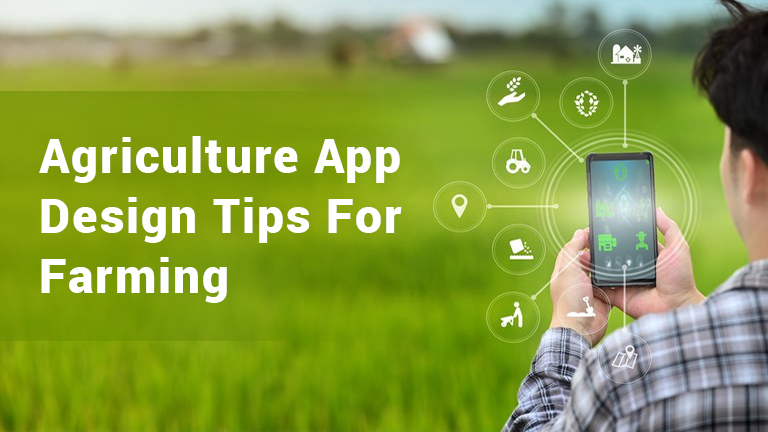How To Create An Agriculture App for a Farm Business

Farming is one such occupation that has existed since the primitive ages. It has witnessed a lot of modernization over the past century, especially over the last few decades. Farming is no longer considered as traditional or conservative. Modern-day farming is innovative and is driven by technology. One would have hardly imagined the connection of mobile technology and farming a few decades ago, but it is a reality in today’s time. A lot of Mobile-Agri applications are being created these days, which positively impact the lives of millions of farmers. In order to create such an app, a good amount of research is required. Plus, there are a few design principles that help in creating the best Agriculture app.
Design principles For Agriculture App
Keep It Simple
Yes, farmers do have access to smartphones today, but the majority of them have smartphones that are not too advanced. Moreover, even if they have advanced smartphones, the probability of them using all the advanced features is very low. Therefore, you need to keep the functionality and features as simple and straightforward as you can. The design must not dictate the content, and everything should be upfront.
The target group’s orientation towards functionalities on mobile devices is minimal, and hence, every feature of the app needs to be obvious. Keep the farmers informed at every stage and drive their confidence simultaneously.
Consider The Network Limitations
Farmers usually operate from the countryside, which may not have the best of network strengths. Therefore, it is necessary to make sure that the agriculture app is extremely light; it must have the capability to load faster even when accessed through a low-speed connection. The design assets must be kept to a minimum, optimally under 10 KB.
Create a Visual-Heavy Agriculture App
We already discussed the limited internet speed issue; hence, it’s vital to keep the visual assets light. However, let’s not forget the fact that our target audience has a low orientation towards reading, which requires to make the app visual-heavy. Include a lot of life-like illustrations so that farmers can easily relate to them. This gives the freedom to control the size of the assets. Consider using relevant effects, like watercolor effects and hand-painted images to connect better with the users.
Design Around Familiar Apps
A thorough study of the target audience is essential. It helps in understanding the usage patterns and behaviors. Farmers are generally familiar with apps like Google and YouTube. This should drive the design and functionality of your app; try to match the usability accordingly. For example, a card-style layout for the agriculture app that’s very similar to Google Feed will improve usability. This will help in offering the content upfront so that the farmers can associate with the app instantaneously.
To take advantage of these technologies all a farmer needs is a smartphone with internet access and a mobile app. Here’s a list of some important features you should include in your agriculture mobile application to make it a useful tool for farmers.
GPS and Location-Based Services
Mapping allows farmers to use lots of location-based features, including tracking drone investigations and seeing local weather forecasts. A location-based service can also help to divide a field into polygons. Each polygon is investigated separately and locations that need extra attention are pinned. With maps, farmers can also locate their speciality crops, pesticide applicators, and more.
Drone Integration
Drones are becoming one of the most important and popular agricultural technologies. With drones, a farmer can see where crops are healthy and weak so they can make adjustments precisely where they’re needed. Thermal cameras on drones can help to detect water leakage and find out how much water crops get. Moreover, drones can spread pesticides and deliver soil samples to a farmer from anywhere.
Broadcasting and Video Calls
Video streaming and broadcasting are also great features for an advisor app. They allow advisors to answer common questions and allow farmers to join live video sessions. Broadcasting also helps farmers share their experience and useful tips, creating a community inside your application.
Camera and Machine Vision
Visual information and machine learning are the core of some agriculture applications. It allows farmers to effectively recognize plant diseases at early stages, identify weeds, check nitrogen levels, and evaluate leaf damage. The biggest challenge in machine learning is getting enough data for the system to learn. However, there are ready databases of plants, their diseases, and so on. You can use these databases and cloud-based approach to build an agriculture application and help farmers.
Integration of Weather Forecast in Agriculture App
Though technology has made farmers less dependent on the environment, the weather is still an important factor when it comes to growing crops. Weather forecast integration is a useful feature for an agriculture app.
Analytics For Agriculture App
Analytics help farmers to determine how successful their precision farming strategy is and how to make it better. Integrating analytics is a great decision for most agricultural apps that help with managing work processes. Analytics should be informative and give valuable insights on resources, crop health, changes in weather conditions, and so on.
Read about reducing the bounce rate for your website here
There are many types of agricultural applications that solve different problems and help farmers work smarter and get better results with less effort. If you’re considering entering this emerging market and you want to make your own farming app, you should start planning your application as soon as possible. Our team of experts can guide you.

